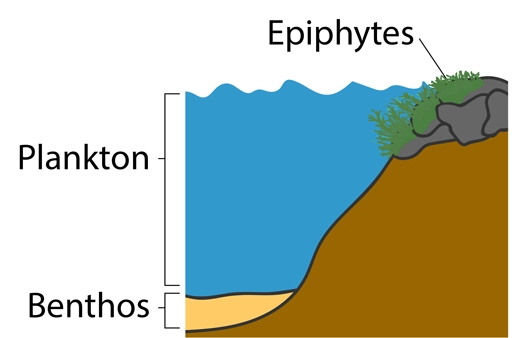
Just fill out the Sample Kit Request form. We'll ship you a sampling kit. Send us back your sample, and we'll process it, photograph, and identify all of the diatoms.
Diatoms are valuable indicators of water quality, so we'll also help you understand what your diatom community says about your local water body. And best of all, thanks to a generous grant from the National Science Foundation, participation is free!
Choose a water body that you're curious about. It doesn't have to be glamorous. In fact, we recommend choosing a water body that's nearby, or one that you see every day, so you can develop a better and deeper appreciation for it. Ponds, lakes, rivers, brooks, ditches, oceans, reservoirs, beaches—you name it. If there's water and sunlight, then it's probably full of diatoms.
Important: Diatoms are so diverse and abundant that you don't have to risk life and limb to collect a great sample with lots of different species. In fact, you can collect a sample without barely getting wet at all! All collections should be made with one or more supervising adults.
Diatoms have pigments that make them appear as orange or golden brown, not green. They often live alongside green algae though, so you can't always see their characteristic golden brown color. In general, samples from recently flooded muddy rivers and lakes won't have many diatoms, and lakes in mid-summer have more green and blue-green algae than diatoms. The myDiatoms team will work with you and offer guidance on where and how to collect the best sample possible.

Epiphytes
Many microorganisms-including diatoms-are epiphytes, meaning that they can grow on the surface of plants, such as green algae which grows on rocks close to the shore.
Plankton
Many diatoms grow passively suspended in the water columns of oceans, lakes, and large rivers. These free-floating, or planktonic diatoms, are part of the phytoplankton community.
Benthos
Many microorganisms—including diatoms—are benthic, meaning that they are found on the bottoms of ponds, lakes, rivers, and oceans. Benthic diatoms grow attached to pretty much anything—rocks, sand, sediment, wood, clam shells, or an old Coke bottle.
Terrestial
Places that are wet but not fully submerged in water are often home to some of the most interesting diatoms. For example, moist mosses, seeps, wet rock walls, and even leaky outdoor faucets and drains are often teeming with diatoms! Here are some examples of terrestrial diatom habitats:

Many diatoms grow attached to seaweeds, aquatic plants, or other algae. If it's wet and in the sun, then there are probably diatoms there. Just grab some of it and stuff it in the tube with some water!
To collect planktonic diatoms, just dunk some plastic bottles (any kind will do) in the water to fill them up. Let the bottles sit undisturbed overnight to let all the diatoms sink to the bottom. Slowly pour off most of the liquid from each bottle, then combine the remaining bottom portions—now concentrated with diatoms—into the provided tube. You should be able to see sediments and small particles at the bottom. If not, you may want to collect several more bottles of water.
Benthic diatoms usually grow attached to rocks, sand, decomposing leaves, or even other organims, so in order to collect benthic diatoms, you need to collect the things they're growing on. You could take a small scoop of sand or sediment (not too deep), collect some submerged leaves or small sticks, or you could grab a rock and brush off all the diatoms with an old toothbrush. The rock will probably start off feeling a little slimy—this is the stuff you want! Dip a toothbrush in the water, brush away at the rock, then rinse off the toothbrush in the collection tube with some water from the habitat you're sampling.
If there's enough running or dripping water, collect enough to fill the collection tube about halfway. Collect moist mosses and plants with your hands or a toothbrush and place in the collection tube. Scrape slippery orangey brown biofilms with a toothbrush, and rinse diatoms off the toothbrush by swirling it in the collection tube (which you filled about halfway with water earlier). For mossy areas, you can grab mosses and scrape with a toothbrush. Get as much as you can in there!
To submit data, scan the QR code on your 50 ml sample tube and complete the Google form.
Make sure the cap is securely fastened, then place the tube in the provided bag. Seal up the bag to prevent leaking.
Put the sample in the shipping box provided. Make sure your project code/number is still on the tube so we know who the sample belongs to! Seal up the box and ship by U.S. Mail. If you're shipping multiple samples or want to tell us some special information about your sample, label the tube, then tell us about it by e-mail or in the provided project sheet (for example, "sample A is from an old McDonald's cup in the park, and sample B is from the boat dock").